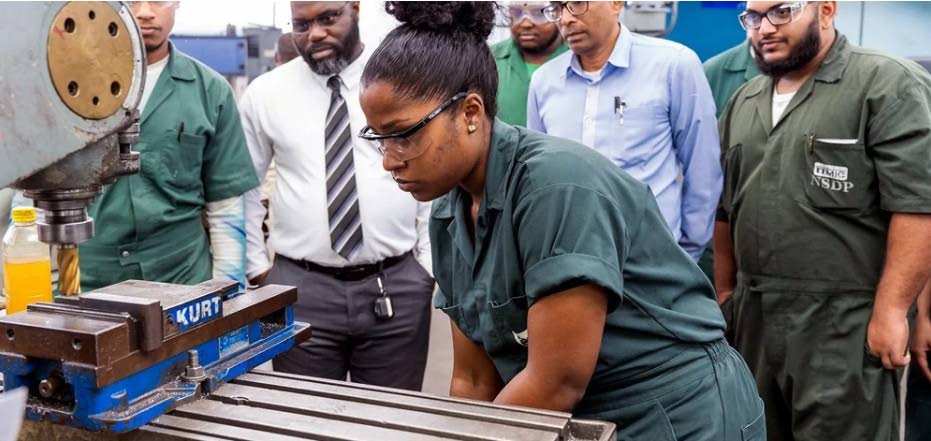By Newsday Reporter
Copyright newsday

Dianne Joseph
There is a lot of talk about youth delinquency, school drop-outs, those involved in crime and criminality and several other negatives. It may be a good time to examine whether our students are all truly inclined to pursue a path of academic excellence or whether the system of “trade education” requires a heavier focus.
In the same manner a country requires doctors, attorneys, teachers, managers, accountants and other academic personnel, we do require the tradesmen such as plumbers, electricians, mechanics, landscapers, painters and woodwork professionals.
The traditional academic pathway, with its emphasis on abstract theory, standardised testing and university preparation, serves many students well. However, for a significant portion, it becomes a source of profound frustration, anxiety and failure.
These are not students lacking intelligence or potential; they are individuals whose talents, learning styles and passions simply do not align with the rigid confines of conventional classrooms.
When countries fail to provide viable alternatives, they risk squandering human potential, perpetuating cycles of disengagement and overlooking critical economic needs.
Investing robustly in high-quality trade education – encompassing fields like plumbing, landscaping, auto electrical work, carpentry, welding and culinary arts – is not just an act of educational equity; it’s a strategic imperative for building resilient individuals and thriving economies.
Governments, in considering ways of supporting this group of students, may consider dismantling stigma and elevating vocational pathways.
This is necessary because one of the most pervasive barrier is the deep-seated societal stigma that positions vocational education as a “lesser” option, a fallback for those who “could not cut it” academically.
Governments must actively lead a cultural shift.
In this connection, awareness campaigns at the national level may be prudent to launch sustained, high-profile campaigns showcasing the dignity, value and sophistication of skilled trades.
Feature successful tradespeople, highlight their earning potential and emphasise their indispensable role in society such as building infrastructure, maintaining essential services or driving innovation. This can be achieved with the use of diverse media such as television, social media and school visits. All aimed at reaching students, parents and educators.
The integration of vocational guidance early with a mandate for a start to comprehensive career counselling with the use of trained counsellors who will be able to recognise diverse aptitudes and passionately present trade careers as equally valid as prestigious university degrees will be a step in the right direction. This, together, with an effective and organised career fair at which tradespeople will demonstrate their skills and discuss their pathways as a form of motivation and confirmation of the promotion of trade.
But, we cannot forget how the students look at language and this must be considered by the official replacement of terms like “vocational school” or “trade school” with more positive descriptors like “technical career institutes,” “skilled trades academies,” or “applied learning centres.”
It is important to ensure that government communications consistently refer to these pathways as “career and technical education” (CTE) or “applied learning,” emphasising skill acquisition and professional readiness.
Funding, infrastructure and the need for building the foundation for excellence and world-class trade education requires significant investment and as such governments must commit substantial resources modernised facilities and equipment along with dedicated capital funding to build and maintain state-of-the-art training centres.
Outdated facilities may signal a lack of seriousness and hinder effective learning.
Training costs may be subsidised to make them accessible in the form of subsidies or full scholarships for tuition, tools, safety gear and certification exams for students pursuing in-demand trades, particularly those from low-income backgrounds.
This will remove the financial barrier that often prevents capable students from enrolling in these programmes.
After all, this is the opportunity to attract the students who are not academically inclined into a space that will serve to motivate them to pursue a successful career.
Given the economic challenges, governments may consider incentivising industry-grade materials and partnerships with industry suppliers to provide materials at reduced costs or through donations.
Governments may also offer tax breaks to companies that contribute equipment or materials to public training programs, ensuring students train with what they will actually use on the job.
There is a need for a curriculum revolution: blending theory, practice and relevance.
Trade education must be dynamic, rigorous and directly connected to the real world.
Governments should drive curriculum innovation and shift away from rigid time-based models.
Develop curricula focused on demonstrable mastery of specific skills and competencies.
Allow students to progress at their own pace, earning micro-credentials or stackable certificates for each mastered module, which may include residential plumbing installation, auto electrical diagnostics and sustainable landscape design, among others.
Embed essential employability soft skills directly into technical training that includes communication with clients, team members, problem-solving, project management, customer service, entrepreneurship basics and digital literacy are skills that are crucial for career success and advancement.
There must be an emphasis on sustainability and technology to ensure curricula reflect modern industry trends.
Incorporate training in green technologies, solar panel installation, water-efficient plumbing, sustainable landscaping practices, advanced diagnostics and emerging automation relevant to each trade.
Partnership and alliances are good for effective trade education and cannot exist in a vacuum.
Governments must act as catalysts for deep, mutually beneficial partnerships and reach out to key stakeholders for support as they seek to establish robust, well-regulated apprenticeship frameworks that combine paid on-the-job training with classroom instruction.
Provide tax credits or wage subsidies to employers who hire and train apprentices.
Set clear standards for training quality, mentorship and progression.
Work-based learning opportunities may be funded to facilitate structured work placements, internships and job shadowing integrated into the curriculum. This provides invaluable real-world experience, helps students build professional networks, and allows employers to identify and recruit future talent.
As we pursue the foregoing, one must take cognisance of the need for mental health and wellbeing services.
We must recognise that students struggling academically may also face other challenges.
Integrating accessible counselling, stress management workshops and resilience training into trade programmes to support overall student wellbeing and success cannot be over-emphasised.
A country must see the support for our students as an investment in human potential and national prosperity.
Students who struggle in traditional academic settings are not failures; they are individuals with unique strengths often untapped by conventional systems.
By strategically investing in, destigmatising and modernising trade education, governments can unlock this vast reservoir of potential.
They can provide pathways to meaningful, well-paying careers that offer dignity, security and the satisfaction of tangible accomplishment. This is not just about helping students “cope” – it’s about empowering them to thrive in fields vital to our everyday lives and economic engine.
These steps have the potential to reduce youth unemployment, address critical skills shortages, boost local economies and foster a more diverse and resilient workforce. Building a robust trade education system is building a stronger, more inclusive and more prosperous future for everyone.
It may be a good time for us to move in a new direction and make the tangible investments that turn potential into power.
A power that is aimed at turning the faces of our young people in another direction, where they will see the positive value in themselves and allow them to turn away from doubt, fear, crime and criminality.



